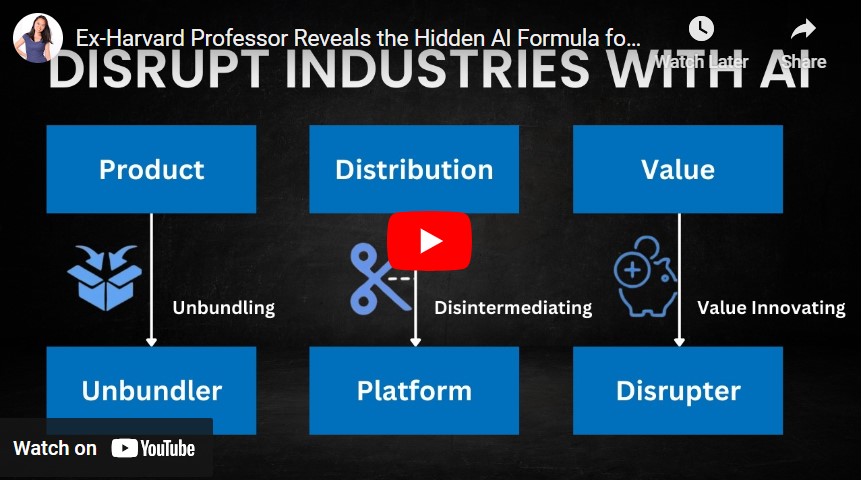
Introduction:
Former Harvard MBA Professor Talis Tashera, drawing from his extensive academic research and consulting experience, shares comprehensive insights on implementing artificial intelligence effectively in modern business environments. Through his detailed analysis and case studies, he advocates for a thoughtful, customer-centric approach to AI adoption. Rather than following the latest technological trends without clear purpose, he emphasizes that companies should carefully evaluate and prioritize solving genuine customer problems. This methodical approach ensures that AI implementations deliver tangible value and sustainable competitive advantages rather than merely following industry hype or implementing technology for its own sake.
How to Use AI in Startups and Businesses
I. Identify Specific Challenges:
- Customer Service:
- Chatbots: Automate initial customer interactions, providing 24/7 support.
- Sentiment Analysis: Gauge customer satisfaction from feedback and social media.
- Marketing and Sales:
- Lead Scoring: Prioritize leads based on their likelihood to convert.
- Personalized Marketing: Tailor campaigns based on individual customer preferences.
- Predictive Analytics: Forecast sales trends and optimize inventory.
- Operations:
- Process Automation: Streamline repetitive tasks like data entry and scheduling.
- Predictive Maintenance: Prevent equipment failures by analyzing sensor data.
- Supply Chain Optimization: Optimize logistics and inventory management.
- Product Development:
- Market Research: Identify new product opportunities and customer needs.
- Product Design: Generate creative designs and prototypes.
- A/B Testing: Optimize product features based on user feedback.
II. Choose the Right AI Tools:
- Consider your budget, technical expertise, and specific needs.
- Explore pre-built AI solutions or custom development.
- Some popular options include:
- ChatGPT: For natural language processing and content generation.
- Google Cloud AI Platform: A comprehensive suite of AI tools.
- Amazon SageMaker: A platform for building, training, and deploying machine learning models.
III. Prepare Your Data:
- Ensure data quality and accuracy.
- Clean and preprocess data to remove inconsistencies and errors.
- Consider data privacy and security regulations.
IV. Implement and Test:
- Start with a pilot project to test the AI solution.
- Monitor performance and gather feedback.
- Iterate and refine the solution based on results.
V. Scale and Integrate:
- Gradually expand the AI solution to other areas of the business.
- Integrate AI seamlessly with existing systems and workflows.
- Continuously train and update the AI models.
Additional Tips:
- Build an AI-literate workforce.
- Develop a clear AI strategy aligned with business goals.
- Address ethical considerations and potential biases.
- Stay informed about the latest AI advancements.
By following these steps, startups and businesses can leverage AI to improve efficiency, reduce costs, enhance customer experiences, and gain a competitive edge :
Video about AI in Startups and Businesses:
Key Sections:
- The Current State of AI Implementation
- Companies are rapidly adopting AI with minimal barriers to entry
- Many businesses struggle with implementing AI effectively
- Case study: McDonald’s drive-thru AI implementation challenges
- Customer Value Chain Analysis
- Framework for understanding customer activities and needs
- Classification of activities into:
- Value creating activities
- Value capturing activities
- Value eroding activities
- Example: Twitch’s success through strategic decoupling
- Finding Problems to Solve
- Focus on customer pain points rather than technology
- Importance of mapping customer value chain
- Methods for identifying weak links in customer experiences
- Example: Car wash industry disruption through subscription model
- AI Implementation Strategy
- Three main categories of AI:
- Generative AI for content creation
- Predictive AI for forecasting
- Automation AI for execution
- Focus on strategic value drivers
- Netflix case study: AI-powered recommendation system
- Three main categories of AI:
- Managing AI Transformation
- Employee concerns and resistance
- Strategies for successful AI adoption
- Importance of redirecting freed-up time to higher-value activities
AI Implementation in Southeast Asia in 5 Years
Southeast Asia is poised to be a major hub for AI innovation and adoption in the next five years. Here’s how AI can be implemented and its potential impact:
Key Areas of AI Implementation:
Agriculture:
- Precision farming: Optimize resource use, predict crop yields, and detect diseases.
- Food safety: Ensure food quality and traceability.
Healthcare:
- Telemedicine: Provide remote healthcare services, especially in rural areas.
- Disease prediction and prevention: Develop early warning systems for infectious diseases.
- Drug discovery: Accelerate the development of new medications.
Education:
- Personalized learning: Tailor education to individual student needs.
- Skill development: Train workers for the jobs of the future.
Smart Cities:
- Traffic management: Optimize traffic flow and reduce congestion.
- Environmental monitoring: Improve air and water quality.
- Public safety: Enhance security and emergency response.
Fintech:
- Credit scoring: Improve access to credit for underserved populations.
- Fraud detection: Prevent financial crimes.
- Personalized financial advice: Provide tailored financial guidance.
Challenges and Considerations:
- Data privacy and security: Ensure responsible data handling and protection.
- Ethical concerns: Address potential biases and ensure fairness in AI systems.
- Skill development: Train a workforce skilled in AI technologies.
- Infrastructure: Invest in robust digital infrastructure to support AI applications.
- Collaboration: Foster collaboration between governments, businesses, and academia.
Potential Impact on Southeast Asia:
- Economic growth: Boost GDP by $950 billion by 2030.
- Improved quality of life: Enhance healthcare, education, and environmental sustainability.
- Increased competitiveness: Position Southeast Asia as a leader in AI innovation.
Conclusion:
The successful integration of artificial intelligence (AI) in businesses relies not only on the technology itself but also on effectively addressing real customer issues. To ensure a prosperous AI implementation, companies should focus on thoroughly analyzing their customer value chain. By identifying weaknesses within this chain, businesses can strategically utilize AI to enhance key value drivers and improve overall customer experience. This approach allows organizations to pinpoint specific pain points in the customer journey where AI solutions can have a significant impact. By aligning AI implementation with the customer value chain, companies can ensure that their technology investments directly contribute to creating value for customers. It is crucial for businesses to understand the importance of leveraging AI strategically to address customer needs and deliver enhanced value throughout the entire value chain. This strategic approach can help companies differentiate themselves from competitors and establish a solid foundation for long-term success in the rapidly evolving digital landscape.
Southeast Asia sees vast opportunities in using AI for economic growth, quality of life enhancement, and building a sustainable society. AI can boost productivity, competitiveness, and job creation in various industries. It can also improve healthcare, transportation, and empower individuals with new skills. Additionally, AI can aid in environmental conservation and bridging the digital divide, promoting inclusivity. By embracing AI, Southeast Asia can advance towards a prosperous, inclusive, and sustainable future.
Key Takeaways:
- Start with customer problems, not technology solutions
- Use the customer value chain framework to identify opportunities
- Apply AI strategically to enhance existing value drivers
- Focus on reducing cost, time, and effort
- Help employees transition to higher-value activities








